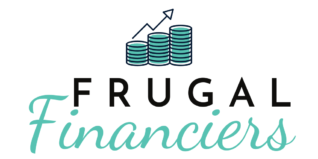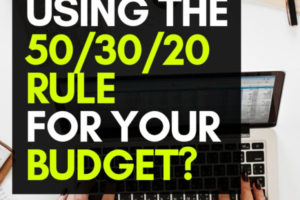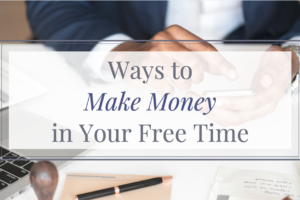Regardless of why you have debt, you’re probably itching to get out of debt as fast as possible.
Debt usually sucks. The interest sucks up our money while we desperately try to pay off the balance.
And, while we believe debt can be great if used for the right things, we still need a debt payoff plan to repay the money.
So, what do you do to get out of debt?
The simple answer is to pay more money than the interest charged each month.
But, there is so much more to it than that.
We know how stressful it can be to look at a debt balance every month without a plan to pay off the debt.
The literal way of getting out of debt is nice but it takes much more than that to become
You may have to change your habits.
You’ll definitely have to change your habits if you want to get out of debt faster.
You should also track your debt reduction.
And, you have to stay motivated to accomplish your goal of paying off your loans and credit cards.
So, what’s the first thing you have to do?
Figure out why you are in debt.
Why Are You In Debt?
Who do you owe money to?
Do you want to get out of credit card debt? Or, student loan debt? Do you have a car loan?
Maybe it’s a combination of these different forms of debt.
But, not all forms of debt and loans are created equally.
The reason why you have student loans is much different than why you have credit card debt.
Let’s discuss each a little bit and how the common forms may impact how to pay off debt.
Student Loans
From millennials to Gen Z, it seems like everyone has student loan debt after graduating from college.
We left college with over $100,000 of student loan debt but we were able to pay if off within two years.
The thing about student loan debt is that it doesn’t reflect a bad spending habit that you might have with other forms of debt.
Still, since most freshly minted college graduates have never focused on their personal finances, it’s important to understand your money situation.
Once you leave college, you will need to start making payments on the student loan debt.
Home Mortgage
Debt from a mortgage is also quite common debt for many people. It is pretty difficult to buy a house with cash sitting in your bank account.
Mortgage interests rates also tend to have the lowest interest rates of any consumer debt. This is because the value of the home is pledged as collateral.
If all you have is a mortgage, you probably should be too stressed about your debt situation. You may even want to consider saving and investing your money instead of paying off extra debt.
The two main situations when it’s time to worry about a mortgage is when you can’t afford to make the monthly payment or if the home is less valuable than the loan.
The second scenario is what happened during the financial recession where homes were depreciated in value and were worth less than the amount owed to the bank.
The first situation is common for people who try to buy as much house as then can, not realizing that they won’t be able to afford other stuff like food and clothing.
If this is the case for you, you may need to consider selling your home or refinancing your mortgage.
Car Loan
Sometimes we need a new car or feel like we need a new car.
For some of you, that means buying a car with loan financing to complete the purchase.
Either you want more car than you have in your bank account or you simply have no money in your bank account.
A car loan can be a source of stress and worry if it’s simply too much money.
If that’s the case, you may need to sell your car and buy a cheaper one or create a plan to pay down your debt quickly.
Credit Card Debt
Credit cards are great.
Credit card interest, not so much.
When you carry a credit card balance each month it means that you don’t completely pay off the credit card balance.
What ever the remainder is, you are charged interest on it. And, that interest is high and costly.
If you have a credit card balance, it means either two things are happening:
- You are spending more money than you each month.
- You are putting your money you didn’t spend somewhere else like investing, savings account or other debt.
You can quickly fix the second situation by making sure that you pay off your credit card balance first before putting extra money towards savings or other debts.
The first situation must be fixed by changing your spending habits.
What do they all have in common?
When ever you have “bad” debt, it is the result of your spending habits.
Instead of buying the $500,000 home, you purchased the $750,000 home.
You could have bought a used car for $6,500 but you bought a new car for $18,000.
After all your necessities, you spent $1,500 more than you earned, putting it on a credit card.
Can debt be considered good or bad? Debt isn’t really good or bad, it’s how you use it.
Your spending habits determine whether you have good debt or bad debt.
Usually, if you’ve grown your debt to a worrisome amount that is stressing you out, it’s probably the result of you making purchases that you shouldn’t have made.
If this is the case, you’re going to have to spend time consciously changing your spending habits.
So how do you do that?
Figure out how much you’re earning and how much you’re spending.
1. Create a Budget
Why should you create a budget?
Because, until you spend less than you earn, you don’t have any extra money to pay off your debt.
If this is your first time creating a budget, check our post on simple budgeting for beginners.
Here is an overview of the first part of the process:
- Gather all of your transactions for a period of time (we recommend the last 3 months)
- Categorize your income and expenses
- Calculate your net income (income minus expense)
- Calculate how much your spending to pay off your debt (interest charged plus paying down long-term balances)
If you follow these steps, you’ll have created a personal income statement which you can use to build a budget.
So, are you earning more than you spend or are you spending more than you earn?
Also, how much are you already spending on debt payments?
This amount should be all of the interest expense you’ve paid during the period as well as any balances that are only partially being paid off.
So, if you pay off your credit card each month that shouldn’t be included but if you’re only paying a portion, the portion paid off should be included.
If you have a net income (earning more than you spend), great!
Do you think your net income plus the amount you’re already spending on your loans and credit cards is sufficient enough to pay off your debt?
If so, then you can move to the next step.
If you are spending more than you earn or you want an even larger amount to pay off your debt you’re going to have to set some budget goals.
Review the areas where you’re spending money that you might be able to reduce expenses.
These tend to be expenses like wants:
- Eating out
- New clothes
- Entertainment
More than necessities:
- Rent
- Electricity
- Basic food and clothing
Just know, this can be short-term until you pay off your debt.
The goal is generate as much extra money as possible.
The more extra money you can create now by reducing expenses, the faster you can pay off debt.
And, the faster you pay down your debt balances, the more money you’ll save in interest expenses in the future.
This will help you pay off your debt even faster.
Now that you know how much you have to spend, it’s time to get to the good part.
2. Create A Debt Overview and Figure Out Which Loans and Credit Cards to Pay Off First
Before you can start putting that extra money to work paying off your debt you have to determine which debts to pay first after making the required minimum payments.
If you only have one loan or credit card balance that you’re trying to pay off, we still recommend gathering this information.
It’s always good to have detailed information for your finances.
What info do you want to collect?
- Balance
- Annual Percentage Rate (APR)
- Minimum or Monthly Required Payment
- Any special details (delayed interest, tax benefits, prepayment fees)
There are a few caveats but generally, your loans and credit cards balances with the highest interest rates (aka APR) should be paid first.
So, pay off debt from the highest interest rate to lowest interest rate.
By doing this rather than other methods, you save extra money in the future through smaller interest charged.
And, you’ll have even more money to put towards your your loans and credit cards.
What about those caveats?
Three caveats are for loans that have delayed interest, tax benefits and/or for loans that charge fees for prepayment.
Some student loans have the first two features.
If you are not being charged interest on a loan for a period of time, it may be better to put your extra money towards another loan that is accruing interest.
This is because you’re effectively paying 0% interest on the loan that has a delayed interest period.
Unfortunately, to figure out which loan to pay first requires some complex math.
As a general rule of thumb, if there is a significant difference in the interest rates between the two loans, it is likely better to still pay off the loan with the highest interest rate first.
The other caveat is much easier to figure out.
If you have loans that allow you to deduct the interest you pay on the loans from your taxes it effectively changes the interest rate of the loan.
This is a simplification but if your interest can reduce your taxable income and your marginal tax rate (the tax rate on an add
A 5% APR (interest rate) would become effectively 4.5% in the scenario above.
In terms of a $1,000 loan where you only pay interest, you pay $500 for the year in interest but you save $50 on your taxes.
The last caveat doesn’t apply to most loans but its always good to check.
Some lenders charge a prepayment fee when you make early payments on a loan.
That sounds terrible, why do they do that?
They were expecting a certain amount of interest income from you and now they’re not going to get as much because you reduced the balance.
Basically, they still want to make money.
If you do get charged a fee it may outweigh paying off another debt balance first.
For more on figuring out which debt to pay first, check out our post:
What Debt Should You Pay Off or Pay Down First?
But, when in doubt pay off the loan with the highest interest rate first after making your minimum or required monthly payments.
4. Create a Debt Payoff Planner
Now that you have an order for which debts you want to pay off first, it’s time to create a schedule for paying off your loans and credit balances.
Using the same time frame as your budget, you can chart out how much money you’re going to allocate to each of your loans and credit cards for each time period.
Start first by scheduling out the minimum payments due for all of your debts.
How much do you have left over after making all of your minimum required payments?
You want to use the remainder and put it towards the first loan that you want to pay off.
You can even put the interest charged into your chart and then figure out your new balance.
Here’s the formula:
Old Balance plus Interest Charged minus Minimum Payment minus Extra Payment equals New Balance.
Or:
Old Balance + Interest – Minimum Payment – Extra Payment = New Balance
5. Time to Super Charge Your Debt Payoff
You’ve figured out what debt to pay first and now you know how much to pay so what’s next?
Cut dem checks!
Just kidding, no one uses checks anymore.
Log on to the website of your lender and make the payment.
If you have to wait until some cash comes in you can also make two payments, the minimum
If you have any trouble making an additional payment, you may need to call your lender to figure out how to make an additional payment.
Student loan lenders and servicers typically have a good online process for making additional payments.
If you do make multiple payments keep track of your documents to make sure the lender or servicer is recording these payments, especially if you are paying with a
We’ve heard of a few horror stories of people having payments lost or having to argue with the bank because the mishaps resulted in additional interest charged.
How to Stay Motivated
Most people like the satisfaction of watching their loan and credit card balances decline.
The main benefit of the (oddly popular) Dave Ramsey Snowball method is that it helps create a tangible reward to stay motivated by paying off each debt balance.
While we like watching the debt balances go down, we really like watching out interest payments go down.
Why?
Debt is money we’ve already spent and have to repay.
Interest is money that we have to pay to use that debt so it is additional money we have to spend.
Lower your interest expense and you lower the additional money that you have to spend thus SAVING YOU MONEY!
It may hurt to pay $100 of interest each month but paying $75 hurts less and only paying $5 feels great.
And when you get to zero?
THAT MEANS YOU’RE OUT OF DEBT, BABY!
Just add up the interest charged for each of your debt balances each month or budget time period and compare it with the last time period.
Even a $5 difference is another $5 you have to put towards your loans and credit cards every month from now own.
And, that $5 creates even less interest you have to pay.
It’s a beautiful cycle of debt repayment where you can use the money saved on interest to further pay down your debt.





Leave a Reply
Your email is safe with us.
You must be logged in to post a comment.